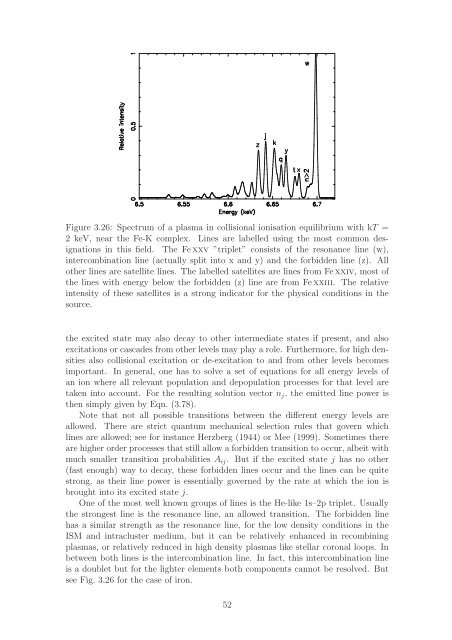Thermal X-ray radiation (PDF) - SRON
Thermal X-ray radiation (PDF) - SRON
Thermal X-ray radiation (PDF) - SRON
You also want an ePaper? Increase the reach of your titles
YUMPU automatically turns print PDFs into web optimized ePapers that Google loves.
Figure 3.26: Spectrum of a plasma in collisional ionisation equilibrium with kT =<br />
2 keV, near the Fe-K complex. Lines are labelled using the most common designations<br />
in this field. The Fexxv ”triplet” consists of the resonance line (w),<br />
intercombination line (actually split into x and y) and the forbidden line (z). All<br />
other lines are satellite lines. The labelled satellites are lines from Fexxiv, most of<br />
the lines with energy below the forbidden (z) line are from Fexxiii. The relative<br />
intensity of these satellites is a strong indicator for the physical conditions in the<br />
source.<br />
the excited state may also decay to other intermediate states if present, and also<br />
excitations or cascades from other levels may play a role. Furthermore, for high densities<br />
also collisional excitation or de-excitation to and from other levels becomes<br />
important. In general, one has to solve a set of equations for all energy levels of<br />
an ion where all relevant population and depopulation processes for that level are<br />
taken into account. For the resulting solution vector n j , the emitted line power is<br />
then simply given by Eqn. (3.78).<br />
Note that not all possible transitions between the different energy levels are<br />
allowed. There are strict quantum mechanical selection rules that govern which<br />
lines are allowed; see for instance Herzberg (1944) or Mee (1999). Sometimes there<br />
are higher order processes that still allow a forbidden transition to occur, albeit with<br />
much smaller transition probabilities A ij . But if the excited state j has no other<br />
(fast enough) way to decay, these forbidden lines occur and the lines can be quite<br />
strong, as their line power is essentially governed by the rate at which the ion is<br />
brought into its excited state j.<br />
One of the most well known groups of lines is the He-like 1s–2p triplet. Usually<br />
the strongest line is the resonance line, an allowed transition. The forbidden line<br />
has a similar strength as the resonance line, for the low density conditions in the<br />
ISM and intracluster medium, but it can be relatively enhanced in recombining<br />
plasmas, or relatively reduced in high density plasmas like stellar coronal loops. In<br />
between both lines is the intercombination line. In fact, this intercombination line<br />
is a doublet but for the lighter elements both components cannot be resolved. But<br />
see Fig. 3.26 for the case of iron.<br />
52
















